美术学专业:《解剖学》课程书籍文献(教学)Artistic Anatomy for Digital Artists Scott Eaton’s
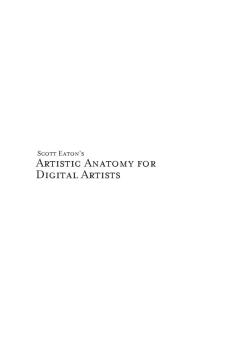
SCOTT EATON'S ARTISTIC ANATOMY FOR DIGITAL ARTISTS
Artistic Anatomy for Digital Artists Scott Eaton’s

C2010 Scott Eaton.www.scott-eaton.com
2 © 2010 Scott Eaton, www.scott-eaton.com
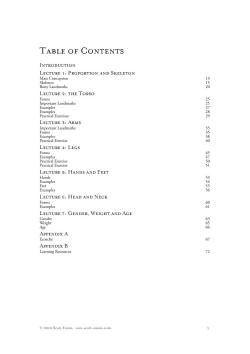
TABLE OF CONTENTS INTRODUCTION LECTURE 1:PROPORTION AND SKELETON 15150 LECTURE 2:THE TORSO Forms ant Landmarks 5517689 P Eriv 15580 LECTURE 4:LEGS Pracical Esere 15701 LECTURE 5:HANDS AND FEET Hands 55456 LECTURE 6:HEAD AND NECK 9 LECTURE 7:GENDER,WEIGHT AND AGE 盈 N DIX A APPENDIX B earning Resources 72 2010 Scott Eaton,www.scott-eaton.com
© 2010 Scott Eaton, www.scott-eaton.com 3 Table of Contents Introduction Lecture 1: Proportion and Skeleton Mass Conception 13 Skeleton 15 Bony Landmarks 20 Lecture 2: the Torso Forms 25 Important Landmarks 25 Examples 27 Examples 28 Practical Exercises 29 Lecture 3: Arms Important Landmarks 35 Forms 35 Examples 38 Practical Exercise 40 Lecture 4: Legs Forms 45 Examples 47 Practical Exercise 50 Practical Exercise 51 Lecture 5: Hands and Feet Hands 53 Examples 54 Feet 55 Examples 56 Lecture 6: Head and Neck Forms 60 Examples 61 Lecture 7: Gender, Weight and Age Gender 63 Weight 65 Age 66 Appendix A Ecorché 67 Appendix B Learning Resources 72
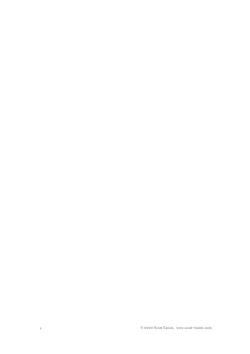
C 2010 Scott Eaton.www.scott-eaton.com
4 © 2010 Scott Eaton, www.scott-eaton.com
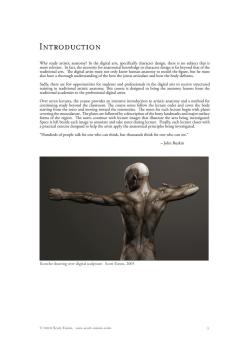
INTRODUCTION d b p ajor that illus mo Hundreds of people talk for one who can think,but thousands think for one who can s. -John Ruskin Ecorche drawing over digital sculpture.Scot Eaton,2005 2010 Scott Eaton,www.scout-eaton.com
© 2010 Scott Eaton, www.scott-eaton.com 5 Introduction Why study artistic anatomy? In the digital arts, specifically character design, there is no subject that is more relevant. In fact, the necessity for anatomical knowledge in character design is far beyond that of the traditional arts. The digital artist must not only know human anatomy to model the figure, but he must also have a thorough understanding of the how the joints articulate and how the body deforms. Sadly, there are few opportunities for students and professionals in the digital arts to receive structured training in traditional artistic anatomy. This course is designed to bring the anatomy lessons from the traditional academies to the professional digital artist. Over seven lectures, the course provides an intensive introduction to artistic anatomy and a method for continuing study beyond the classroom. The course notes follow the lecture order and cover the body starting from the torso and moving toward the extremities. The notes for each lecture begin with plates covering the musculature. The plates are followed by a description of the bony landmarks and major surface forms of the region. The notes continue with lecture images that illustrate the area being investigated. Space is left beside each image to annotate and take notes during lecture. Finally, each lecture closes with a practical exercise designed to help the artist apply the anatomical principles being investigated. “Hundreds of people talk for one who can think, but thousands think for one who can see.” – John Ruskin Ecorche drawing over digital sculpture. Scott Eaton, 2005
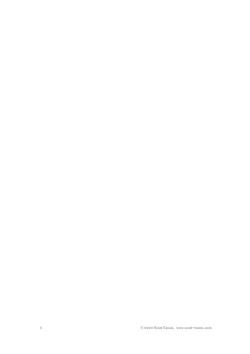
6 C2010 Scott Eaton.www.scott-eaton.com
6 © 2010 Scott Eaton, www.scott-eaton.com
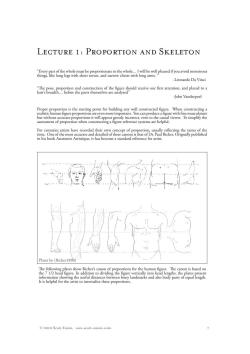
LECTURE 1:PROPORTION AND SKELETON regtickmeemaoihetaodcmepsodfouoidmoasous -Leonardo Da Vinci -John Vanderpoel constructin re proport ven more im 雪红 Plates by [Richer190 eful dist 2010 Scott Eaton,www.scout-eaton.com
© 2010 Scott Eaton, www.scott-eaton.com 7 “Every part of the whole must be proportionate to the whole. I will be well pleased if you avoid monstrous things, like long legs with short torsos, and narrow chests with long arms. “ -Leonardo Da Vinci “The pose, proportion and construction of the figure should receive our first attention, and placed to a hair’s breadth. before the parts themselves are analysed” -John Vanderpoel Proper proportion is the starting point for building any well constructed figure. When constructing a realistic human figure proportions are even more important. You can produce a figure with fine musculature but without accurate proportions it will appear grossly incorrect, even to the casual viewer. To simplify the assessment of proportion when constructing a figure reference systems are helpful. For centuries artists have recorded their own concept of proportion, usually reflecting the tastes of the time. One of the most accurate and detailed of these canons is that of Dr. Paul Richer. Orignally published in his book Anatomie Artistique, it has become a standard reference for artist. Lecture 1: Proportion and Skeleton Plates by [Richer1890] The following plates show Richer’s canon of proportions for the human figure. The canon is based on the 7 1/2 head figure. In addition to dividing the figure vertically into head lengths, the plates present information showing the useful distances between bony landmarks and also body parts of equal length. It is helpful for the artist to internalise these proportions
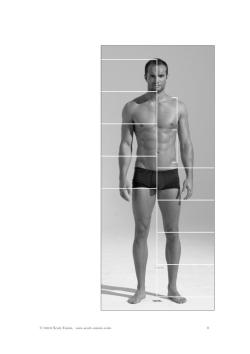
2010 Scott Eaton,www.scout-eaton.com
© 2010 Scott Eaton, www.scott-eaton.com 8
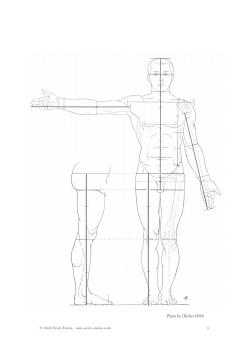
Plates by [Richer1890] 2010 Scott Eaton,www.scout-eaton.com
© 2010 Scott Eaton, www.scott-eaton.com 9 Plates by [Richer1890]
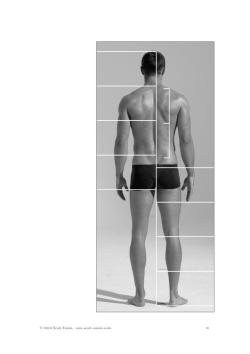
C2010 Scott Eaton,www.scout-eaton.com
© 2010 Scott Eaton, www.scott-eaton.com 10
按次数下载不扣除下载券;
注册用户24小时内重复下载只扣除一次;
顺序:VIP每日次数-->可用次数-->下载券;
- 美术学专业:《解剖学》课程书籍文献(教学)英文 艺用人体绘画解剖指南.pdf
- 美术学专业:《解剖学》课程书籍文献(教学)英文 人体艺术绘画Art_Of_Drawing_The_Human_Body.pdf
- 美术学专业:《解剖学》课程书籍文献(教学)英文 人体解剖学Eliot_Goldfinger_-_Human_Anatomy_for_Artists.pdf
- 美术学专业:《解剖学》课程书籍文献(教学)英文 [向米开朗基罗学习人体绘画]Lessons.from.Michelangelo.pdf
- 美术学专业:《解剖学》课程书籍文献(课外)Vilppu绘画圣经——绘制人物 The VILPPU DRAWING MANUAL.pdf
- 美术学专业:《解剖学》课程书籍文献(课外)Vilppu绘画圣经——-人物组合 Vilppu's Mastering Composition.pdf
- 美术学专业:《解剖学》课程书籍文献(课外)Vilppu绘画圣经——人物画 Vilppu Figure Drawing Demonstrations Step-by-Step.pdf
- 美术学专业:《解剖学》课程书籍文献(课外)Vilppu绘画圣经——绘制头部 Vilppu Head Drawing and Anatomy,Volume One,Glenn V. Vilppu.pdf
- 美术学专业:《解剖学》课程书籍文献(课外)Vilppu绘画圣经——绘制衣服的褶皱 Vilppu Drawing Drapery The Clothed Figure.pdf
- 美术学专业:《解剖学》课程书籍文献(课外)Vilppu绘画圣经——动物的绘制.pdf
- 美术学专业:《解剖学》课程书籍文献(课外)Vilppu绘画圣经——绘制手和脚 Drawing Feet Vilppu And Hands.pdf
- 美术学专业:《解剖学》课程书籍文献(课外)向大师学绘画艺用解剖(罗伯特·贝弗利·黑尔).pdf
- 美术学专业:《解剖学》课程书籍文献(课外)最全的人体肌肉图解(高清晰).pdf
- 美术学专业:《解剖学》课程书籍文献(课外)國外FORCE人体速写高级技法教程.pdf
- 美术学专业:《解剖学》课程书籍文献(课外)标准人体肌肉3D解剖图(Muscle System).pdf
- 美术学专业:《解剖学》课程书籍文献(课外)國外经典手部素描 肌肉结构 动作造型 详细教学.pdf
- 美术学专业:《解剖学》课程书籍文献(课外)國外教你用结构方法绘制动漫人物与动物.pdf
- 美术学专业:《解剖学》课程书籍文献(课外)国外人体动态结构素描详析 Burne Hogarth DYNAMIC FIGURE DRAWING.pdf
- 美术学专业:《解剖学》课程书籍文献(课外)国外人像素描详细教程 THE ART OF DRAWING Drawing Portraits FACES AND FIGURES GIOVANNI CIVARDI.pdf
- 美术学专业:《解剖学》课程书籍文献(课外)国外动漫人物动态结构绘画技巧教学.pdf
- 美术学专业:《解剖学》课程书籍文献(教学)Burne Hogarth - Dynamic Anatomy(Revised and Expanded).pdf
- 《声乐表演与实践》课程教学大纲(含声乐基础理论及欣赏).pdf
- 《声乐表演与实践》课程授课教案(石河子大学:刘希里).doc
- 《声乐表演与实践》课程教学资源(授课教案)声乐基础(二).doc
- 《声乐表演与实践》课程教学资源(授课教案)声乐表演(二).doc
- 《声乐表演与实践》课程教学资源(授课教案)闻声乐基础(二).doc
- 《声乐表演与实践》课程教学资源(授课教案)闻声乐表演(二).doc
- 《声乐表演与实践》课程教学资源(授课教案)闻声乐基础(四).doc
- 《声乐表演与实践》课程教学课件(PPT讲稿)合唱与指挥.ppt
- 《英文小说与电影》课程教学资源 English Novels and Films(自编资料,石河子大学:吴方敏、陈晨).doc
- 《英文小说与电影》课程授课教案(部分内容,共十二讲).docx
- 《英文小说与电影》课程教学资源(部分单元教学设计及思路).doc
- 《英文小说与电影》课程教学课件(PPT讲稿)The Color Purple.ppt
- 《英文小说与电影》课程教学课件(PPT讲稿)Charlotte Bronte and Jane Eyre.ppt
- 《英文小说与电影》课程教学课件(PPT讲稿)勃朗特三姐妹 The Bronte Sisters.ppt
- 《英文小说与电影》课程教学课件(PPT讲稿)喜福会 The Joy Luck Club.ppt
- 《英文小说与电影》课程教学课件(PPT讲稿)N.H.科琳宝姆与死亡诗社.ppt
- 《英文小说与电影》课程教学课件(PPT讲稿)The Kite Runner.ppt
- 《英文小说与电影》课程教学课件(PPT讲稿)狄更斯与雾都孤儿 Charles Dickens(1812—1870).ppt
- 《英文小说与电影》课程教学课件(PPT讲稿)傲慢与偏见 - 简奥斯丁 Jane Austen.ppt
